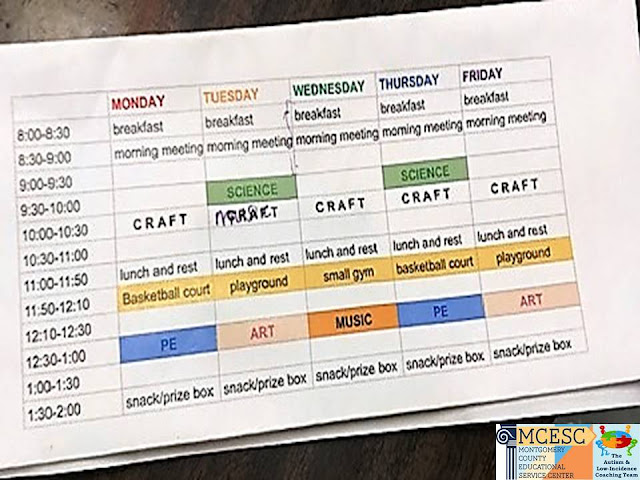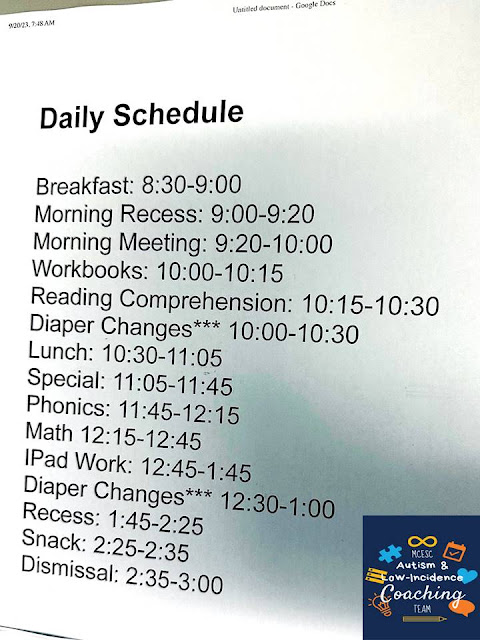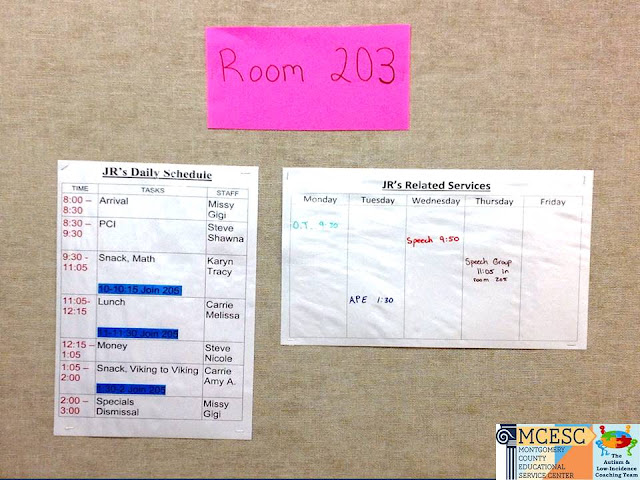Today's Super Star Schedules post will use examples from around our region to illustrate the different stages of developing a schedule for classroom staff and clearly communicating so that everyone can implement the routine with consistency.
Step 1: Overview Schedule
The first step is to create a general outline of your schedule which outlines daily activities and at which times they occur.
 |
| Taylor Anglin Louise Troy Elementary, Dayton |
 |
| Lia Andrix Learning Center- West, MCESC |
 |
| Courtney Pearce Trotwood ELC, Trotwood |
 |
| Phil Beresic Ruskin Elementary, Dayton |
 |
| Nicole Bellard Fairview Elementary, Dayton |
 |
| Granville Bastin Twin Valley South, Preble County ESC |
For older grades, this is often pre-determined through the school building's block schedule.
 |
| Hayward Middle School, Springfield |
 |
| Fairborn High School, Fairborn |
 |
| Michelle Hiegel Miami East Junior High, Miami East |
Step 2: Detailed Schedule
The next step is to detail who is covering what during each time period and activity. For staff schedules, this often includes which student(s) they are working with. This is an important step because it ensures that staff know exactly who to be working with at a given time so that you can be sure all students have coverage at all times.
 |
| Abbie Opdycke Kenwood Elementary, Springfield |
 |
| Christine Scarborough Tecumseh Elementary, Xenia |
 |
| Steve Mahle Miamisburg Middle School, Miamisburg |
Color-coding can make it easier visually for staff to follow the schedule.
 |
| Mandy Schetter Northmoor Elementary, Northmont |
 |
| Anjie Rose Schnell Elementary, West Carrollton |
 |
| Chris Stanley & Nick Moore Kleptz ELC, Northmont |
 |
| Heidi Grumpp Miami County CLC |
Many teams also incorporate this detail into their daily Google Slide Schedules to communicate to staff and students who will be together during centers time.
 |
| Jodi Schweikardt Kiser Elementary, Dayton |
 |
| Tava Reese West Carrollton ECC, West Carrollton |
 |
| Mandi Haynes Perrin Woods Elementary, Springfield |
Step 3: Lesson Plans and Materials
The final step with schedule creation is using the detailed schedule to provide most explicit direction through a lesson plan which may detail specific activities that will be done during that given time.
 |
| Amy Beanblossom Arcanum-Butler Elementary, Arcanum |
 |
| Heather Clark Saville Elementary, Mad River |
 |
| Polly Amspaugh Roosevelt Elementary, Dayton |
 |
| Brittany Wendling Valley Elementary, Beavercreek |
 |
| Jenna Fitch Demmitt Elementary, Vandalia |
Many teams organize staff materials to align with the provided lesson plans in a predictable way so that everything needed is easily accessible to limit down time and waiting for students who need immediate engagement.
 |
| Amy Beanblossom Arcanum-Butler Elementary, Arcanum |
 |
| Taylor Ruef Stevenson Elementary, Mad River |
 |
| Jackie Vollmer Driscoll Elementary, Centerville |
Step 4: Staff Communication Corner
A "bonus" step that makes the schedule process even easier is creating a staff communication corner where extra schedules can be posted and schedule concerns can be communicated on a whiteboard or parking lot. This simple step can eliminate interruptions during the school day when staff need to know what to do next or notice an issue with the schedule because there is a consistent place where this information can be communicated.
 |
| Molly Magoteaux Kleptz Elementary, Northmont |
 |
| Jamie Minnish Prass Elementary, Kettering |
 |
| Jackie Vollmer Driscoll Elementary, Centerville |























